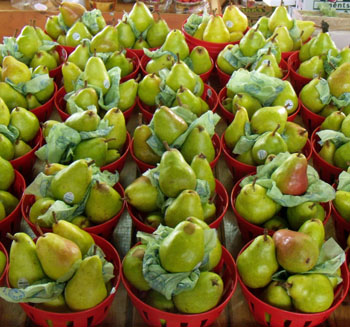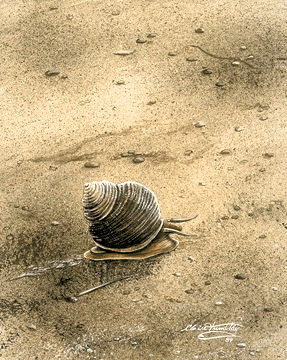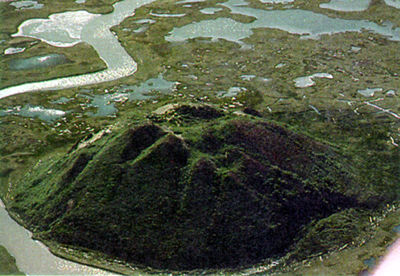Browse "Nature & Geography"
-
Article
Peach
The peach (Prunus persica) is the most widely grown stone fruit. It is native to China and was introduced to Europe 2,000 years ago. Peaches are now grown in temperate zones, worldwide.
"https://d2ttikhf7xbzbs.cloudfront.net/media/media/fb8c1081-f2fa-4a00-848f-89df93bd69cd.jpg" // resources/views/front/categories/view.blade.php
https://d2ttikhf7xbzbs.cloudfront.net/media/media/fb8c1081-f2fa-4a00-848f-89df93bd69cd.jpg
-
Article
Pear
The pear (genus Pyrus) is a common name for over 20 species of fruit-bearing and ornamental trees of the rose family.
"https://d2ttikhf7xbzbs.cloudfront.net/media/media/31c0ebb8-704b-4744-a9da-2776a02399be.jpg" // resources/views/front/categories/view.blade.php
https://d2ttikhf7xbzbs.cloudfront.net/media/media/31c0ebb8-704b-4744-a9da-2776a02399be.jpg
-
Article
Peat
Peat, living and partially decomposed organic matter, consists principally of decayed brown mosses, Sphagnum plants, sedges and other semiaquatic plant remains.
"https://development.thecanadianencyclopedia.ca/images/tce_placeholder.jpg?v=e9dca980c9bdb3aa11e832e7ea94f5d9" // resources/views/front/categories/view.blade.php
https://development.thecanadianencyclopedia.ca/images/tce_placeholder.jpg?v=e9dca980c9bdb3aa11e832e7ea94f5d9
-
Article
Pelican
The Pelican family (Pelecanidae) consists of large water birds with long, flat bills, expandable throat pouches, and 4 toes connected by a web.
"https://d2ttikhf7xbzbs.cloudfront.net/media/media/c123ac85-2333-4f57-965f-1487110ce880.jpg" // resources/views/front/categories/view.blade.php
https://d2ttikhf7xbzbs.cloudfront.net/media/media/c123ac85-2333-4f57-965f-1487110ce880.jpg
-
Article
Pepper
Pepper (Capsicum annuum) is a perennial plant, cultivated as an annual and belonging to the nightshade family.
"https://d2ttikhf7xbzbs.cloudfront.net/media/media/63e5fe3e-d018-4a90-bfa7-b4e1e6fd7997.jpg" // resources/views/front/categories/view.blade.php
https://d2ttikhf7xbzbs.cloudfront.net/media/media/63e5fe3e-d018-4a90-bfa7-b4e1e6fd7997.jpg
-
Article
Perch
Although perch is the common name for several distantly related species of fish, it properly refers to members of the perch family (Percidae), order Perciformes, class Actinoperygii.
"https://d2ttikhf7xbzbs.cloudfront.net/media/media/ae4facef-a398-4f30-a15e-4509a3815a43.jpg" // resources/views/front/categories/view.blade.php
https://d2ttikhf7xbzbs.cloudfront.net/media/media/ae4facef-a398-4f30-a15e-4509a3815a43.jpg
-
Article
Peregrine Falcon
The peregrine falcon (Falco peregrinus) is a crow-sized, long-winged bird of prey, generally acknowledged to be the swiftest bird (attaining speeds of over 320 km/h).
"https://d2ttikhf7xbzbs.cloudfront.net/media/media/1f073f28-bd23-431b-b808-03a84178fec0.jpg" // resources/views/front/categories/view.blade.php
https://d2ttikhf7xbzbs.cloudfront.net/media/media/1f073f28-bd23-431b-b808-03a84178fec0.jpg
-
Article
Periglacial Landform
A periglacial landform is a feature resulting from the action of intense frost, often combined with the presence of permafrost. Periglacial landforms are restricted to areas that experience cold but essentially nonglacial climates.
"https://d2ttikhf7xbzbs.cloudfront.net/media/media/abcd7af0-a9a4-4141-9543-193539282103.jpg" // resources/views/front/categories/view.blade.php
https://d2ttikhf7xbzbs.cloudfront.net/media/media/abcd7af0-a9a4-4141-9543-193539282103.jpg
-
Article
Periwinkle
Periwinkle is a common name for any of the edible intertidal snails of the genus Littorina. Periwinkles are represented by 6 species in Canadian coastal waters.
"https://d2ttikhf7xbzbs.cloudfront.net/media/media/89a4e691-d72e-4af1-a2f2-3f608f6f525b.jpg" // resources/views/front/categories/view.blade.php
https://d2ttikhf7xbzbs.cloudfront.net/media/media/89a4e691-d72e-4af1-a2f2-3f608f6f525b.jpg
-
Article
Permafrost
Permafrost is ground remaining at or below 0°C continuously for at least two years. About 50 per cent of Canada is underlain by permafrost, mainly in the Arctic Archipelago, Yukon, Northwest Territories and Nunavut.
"https://d2ttikhf7xbzbs.cloudfront.net/media/media/5e658751-a56e-4535-9950-f641ec565a97.jpg" // resources/views/front/categories/view.blade.php
https://d2ttikhf7xbzbs.cloudfront.net/media/media/5e658751-a56e-4535-9950-f641ec565a97.jpg
-
Article
Persistent Organic Pollutants
Persistent organic pollutants (POPs) are carbon-based chemical compounds or groups of chemical compounds of anthropogenic (resulting from human activities) origin that are biologically and chemically inert.
"https://development.thecanadianencyclopedia.ca/images/tce_placeholder.jpg?v=e9dca980c9bdb3aa11e832e7ea94f5d9" // resources/views/front/categories/view.blade.php
https://development.thecanadianencyclopedia.ca/images/tce_placeholder.jpg?v=e9dca980c9bdb3aa11e832e7ea94f5d9
-
Article
Pesticide
Substances used to control pests include insecticides (for control of insects), fungicides (for disease-causing fungi), herbicides (for weeds), rodenticides (for rodents), avicides (for birds), piscicides (for fish) and nematicides (for nematodes).
"https://development.thecanadianencyclopedia.ca/images/tce_placeholder.jpg?v=e9dca980c9bdb3aa11e832e7ea94f5d9" // resources/views/front/categories/view.blade.php
https://development.thecanadianencyclopedia.ca/images/tce_placeholder.jpg?v=e9dca980c9bdb3aa11e832e7ea94f5d9
-
Article
Phalarope
The phalarope (family Scolopacidae) is a sandpiperlike shorebird, highly specialized for aquatic life. Only 3 species are found worldwide and all occur in Canada.
"https://d2ttikhf7xbzbs.cloudfront.net/media/media/d793e666-09d5-463f-8dc8-cd470ebb9b37.jpg" // resources/views/front/categories/view.blade.php
https://d2ttikhf7xbzbs.cloudfront.net/media/media/d793e666-09d5-463f-8dc8-cd470ebb9b37.jpg
-
"https://d2ttikhf7xbzbs.cloudfront.net/media/media/752356fc-d886-4733-af69-08e77cf48f2f.jpg" // resources/views/front/categories/view.blade.php
https://d2ttikhf7xbzbs.cloudfront.net/media/media/752356fc-d886-4733-af69-08e77cf48f2f.jpg
-
Article
Phlox
Tall, vibrantly coloured summer-flowering phlox, derived from eastern North American P. paniculata, one of the most popular garden perennials in Canada, is often used for island beds or as border plants.
"https://development.thecanadianencyclopedia.ca/images/tce_placeholder.jpg?v=e9dca980c9bdb3aa11e832e7ea94f5d9" // resources/views/front/categories/view.blade.php
https://development.thecanadianencyclopedia.ca/images/tce_placeholder.jpg?v=e9dca980c9bdb3aa11e832e7ea94f5d9
